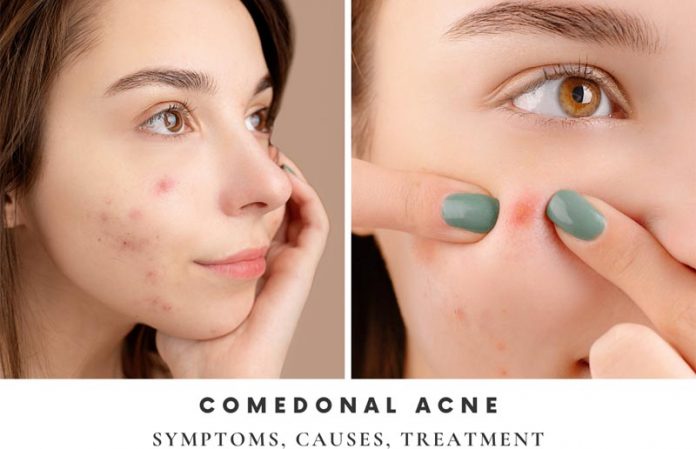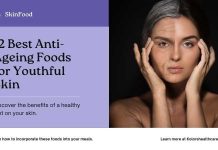The desire for smooth and beautiful skin is universal, yet potholes often pave the way to perfection. Indeed, quite literally! Comedonal acne is another form of acne distinguished by a tiny, inflammatory pimple. Comedonal acne, unlike cystic acne, is not caused by deep skin inflammation. Instead, this form of acne develops when dead cells and microorganisms accumulate on the surface of your skin.
What are comedones on the face?
Teenagers and adults with oily skin are more prone to develop comedone acne on their forehead, nose, chin, and jawline. They are typically inflammation-free (no redness or swelling) but can sometimes cause painful breakouts.
Blackheads and Whiteheads
Blackheads, also known as open comedones, are tiny, black lumps on the skin’s surface. Because the hole is open, the contents of the obstructed pore are exposed to the air, causing oxidation and turning them black.
Conversely, whiteheads are closed comedones that show on the skin’s surface as tiny, flesh-colored, or white pimples. These arise when the pore is closed and the blocked pore’s contents are not exposed to air.
Both blackheads and whiteheads are frequent comedonal acne symptoms. They might be aggravating, but they can be efficiently treated.
Difference between Blackheads and Whiteheads
| Blackheads | Whiteheads |
|---|---|
| Open pores | Closed pores |
| Oxidized oil | Trapped oil |
| Dark color | White/yellow color |
| Not inflamed | Not inflamed |
| Hard to remove | Easy to remove |
Causes of Comedonal Acne
As previously stated, comedones are caused by excess sebum production, which causes dead skin cells and debris to become stuck in the skin’s pores, growing bacteria and forming a blockage on the skin’s surface.
- Hormonal changes: Particularly during adolescence, can cause the sebaceous glands to generate more oil, leading to comedonal acne.
- Genetics: Comedonal acne can also be inherited, meaning it runs in families.
- Skincare and cosmetics: Some skincare and cosmetic items that are heavy or greasy might clog pores and cause the growth of comedones.
- Medications: As a side effect, several drugs, such as steroids and some birth control pills, can induce comedonal acne.
- Diet: Consuming a diet heavy in dairy products, refined carbs, and sweets has been linked to the development of comedonal acne.
- Environmental factors: Pollution and exposure to certain chemicals can contribute to developing comedonal acne.
- Adult smoking habits might result in this type of acne.
- Constant skin picking causes follicle damage/injury.
- A lack of cleanliness and an ineffective skin care program.
Treatment options for Closed Comedonal Acne
Depending on the severity of the illness, there are numerous treatment options for closed comedonal acne. Some of the most common treatments include:
Over-the-counter treatments
Many topical medications, like benzoyl peroxide, salicylic acid, and retinoids, are available over the counter and can help to unclog pores and decrease irritation. For mild occurrences of comedonal acne, these products are generally the initial line of therapy. One of the standard over-the-counter medicine Proactiv solution or amine-benzoyl peroxide combination. A 2% wash of Salicylic acid is also effective in removing closed comedonal acne. A lot of soaps available from pharmacies also help that contain benzoyl peroxide.
Prescription drugs
The primary target for most types of acne treatment is microcomedone. Topical retinoid therapy prevents follicular blockage and excessive cornification. A dermatologist might prescribe oral or topical medications such as topical antibiotics, topical or oral retinoids, or hormonal therapies for more severe instances (for females). Because some drugs are more potent than over-the-counter medications and may have more significant adverse effects, they should only be taken under the supervision of a healthcare expert. Some of the primary topical retinoids that are used in the treatment are tazarotene, adapalene, and tretinoin.
Light therapy
Certain types of light therapy, such as blue light therapy, can help to kill acne-causing bacteria and reduce inflammation. This blue and blue-red light has the best efficacy, where it can treat mild to moderate acne lesions. This treatment is usually done in a dermatologist’s office and may require several sessions.
Chemical peels
The skin is exfoliated with a chemical solution. It removes the dead skin cells from the top layer and unclogs pores. This treatment can help reduce comedonal acne’s appearance and improve skin texture.
Comedone extraction
It removes comedones from the skin using a particular instrument or extractor. A dermatologist or certified aesthetician often performs this technique after the skin has been cleansed and prepped. Comedone extraction removes comedones from the skin using a particular instrument or extractor. A dermatologist or certified aesthetician often performs this technique after the skin has been cleansed and prepped. Minimum or no residual scarring is seen after the treatment procedure. It is one of the best procedures for people who want rapid acne clearance.
How do you get rid of Comedones naturally?
While there is no one-size-fits-all natural cure for comedonal acne, there are several measures you can take to help lessen the appearance of comedones on your skin. Here are a few natural therapies that may be beneficial:
- Tea tree oil contains antibacterial and anti-inflammatory characteristics that can prevent comedones.
- Fresh aloe vera gel should be applied to your skin. Aloe vera contains anti-inflammatory characteristics, which can help to lessen the redness and swelling associated with comedonal acne.
- Honey contains antimicrobial qualities and can aid in reducing irritation and redness associated with comedonal acne. Apply honey straight to your skin before rinsing with warm water after a few minutes.
- Green tea has antioxidants that can aid in reducing inflammation and the battle against acne-causing bacteria. Green tea can be brewed and used as a toner or applied straight to the skin.
- Including fruits and vegetables in your diet can improve overall skin health.
- Apply face cleansers explicitly designed for acne-prone skin, and avoid exfoliating your skin too harshly.
- If you have oily skin, choose a water-based moisturizer over an oil-based one.
- Be sure that the skincare and cosmetics you use are non-comedogenic.
- To avoid blocked pores and pimples, remove your makeup before bed.
- Inform your doctor if a particular medicine creates pimples on your skin.
- Quit smoking if you are a smoker!
- A well-balanced diet with little dairy and sugar and moderate exercise is terrific for your waistline and skin.
- Nurture your skin regularly and maintain it clean and fresh at all times.
Conclusion
Eradicating comedonal acne breaks down to a thorough cleanse and proper topical medication. The process is lengthy, and the commitment is long-term, but there’s no question that it’s worth it. Comedonal acne can be tough to manage independently, so get guidance from a healthcare expert. Patience is also essential when dealing with inflammatory acne. Finally, remembering comedonal acne needs long-term therapy, and control is also critical.
Our skilled dermatologists at Kolors Healthcare provide best-in-class treatment for acne with tailored care for all skin types. We manage mild, moderate, and severe breakouts successfully while preventing scarring. Please make an appointment with us now to receive the customized treatment you require for healthy, clean skin.
Comedonal Acne FAQs
Is comedonal acne permanent?
Comedonal acne is not always permanent and is treatable with the proper skincare routine and a skilled professional’s help. However, one must follow a regular skincare program which is critical to avoid recurring breakouts and scars. In most cases, long-term care may be required to control comedonal acne.
Do comedones go away on their own?
No, comedones might not go away on their own. However, left untreated, it can progress to more severe acne and cause scarring. In addition, it requires therapy to be removed from the skin. To find the best treatment, visit a dermatologist or professional aesthetician.
What worsens comedonal acne?
Anything applied on the face can sometimes trigger or worsen comedonal acne. In addition, poor skincare practices, hormonal shifts, pore-clogging cosmetics or pharmaceuticals, stress, and a diet heavy in sugar, dairy, and processed foods can aggravate comedonal acne.
What foods cause closed comedones?
Consuming processed foods, such as sweets, fats, and fried meals, can influence skin health. High intakes of dairy products are linked to an inflammatory reaction in certain people, resulting in severe acne and closed comedones.
Should I pop my comedonal acne?
It may be tempting to pop the acne, but skincare experts always advise against it. Popping a pimple results in you getting an infection and scarring and making the blemish more inflammatory and visible. Further, it also slows down the normal healing process.









